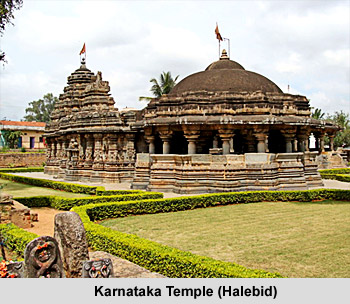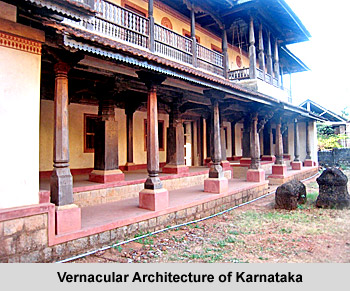 Vernacular architecture of Karnataka symbolises houses designed and built by people for their own use. It is the form that a neighbourhood or community has arrived at, through a system of development, in a precise cultural, climatic and technological context. The architectural scene after independence presents some overwhelming changes, most significant being the influence of the western culture. The most notable development in the recent years has been the idea of vernacular architecture, which is unique form of design. The architecture in India is constantly changing and the prospect of the modern and the vernacular coming together points towards an exciting period of new creativity in our architecture.
Vernacular architecture of Karnataka symbolises houses designed and built by people for their own use. It is the form that a neighbourhood or community has arrived at, through a system of development, in a precise cultural, climatic and technological context. The architectural scene after independence presents some overwhelming changes, most significant being the influence of the western culture. The most notable development in the recent years has been the idea of vernacular architecture, which is unique form of design. The architecture in India is constantly changing and the prospect of the modern and the vernacular coming together points towards an exciting period of new creativity in our architecture.
Significance of the Term-Vernacular Architecture
Probably the term `vernacular architecture` was initially used only on a negative sense by that it is not designed by architects. Later people came to understand that vernacular architecture is predominantly the architecture of houses designed and built by people for their own use. It is the form that a society has arrived at, through a process of growth and expansion, in a particular tradition, climatic and industrial milieu. The forms are not stagnant, they grow continuously, albeit slowly, in response to literary and technological changes. In view of the progressive nature of this method, it is often possible to claim that the vernacular achieves total rapport between lifestyle and built-form.
The built-form only provides an unobtrusive backdrop for the myriad varieties of activity that constitute home-life. It is so much part of life, merging and almost participating in the lifestyle. Architecture is valued not because of its canonical/stylized excellence, but due to its ability to provide an atmosphere, an intangible quality that converts a mere building into a home. This architecture is to be lived-in and experienced and is not to be merely looked-at and admired.
The house provides a canvas for the individual to express his artistic leanings. A piece of `rangoli` here, a carving on the doorjamb there, or the ornate design around the `niche` for an icon are all situations that lead to decorative folk art. It is significant that there is a very high degree of participation by the owner in the act of embellishing his house. The house becomes an intimate part of his life in the process.
 It is probably useful to examine the mechanism by which such a total rapport between lifestyle and built from is achieved in vernacular architecture. The very word `vernacular` conjures up images of a folk idiom and a language spoken intimately in a family. It is possible that a well-knit community arrives at patterns of built-form which acquire symbolic meaning due to years of usage, in a specific cultural context. Maybe it is the way in which the entrance to the house is organized, or maybe it is the manner in which the windows and doors are arranged; the patterns start conveying messages and speaking the language of vernacular architecture, as it were. Here then are the elements of folk architecture, which the house owner and the local artisan pick up and use as the building blocks of a subconscious but evolutionary, local building style.
It is probably useful to examine the mechanism by which such a total rapport between lifestyle and built from is achieved in vernacular architecture. The very word `vernacular` conjures up images of a folk idiom and a language spoken intimately in a family. It is possible that a well-knit community arrives at patterns of built-form which acquire symbolic meaning due to years of usage, in a specific cultural context. Maybe it is the way in which the entrance to the house is organized, or maybe it is the manner in which the windows and doors are arranged; the patterns start conveying messages and speaking the language of vernacular architecture, as it were. Here then are the elements of folk architecture, which the house owner and the local artisan pick up and use as the building blocks of a subconscious but evolutionary, local building style.
There are some further features of the vernacular style which need to be emphasized. The above argument on the process of development of this architecture clearly indicates the possibility of generating an immense variety of forms. In spite of the possibility of great variety, there is also an undercurrent of unity in the various forms. No two neighbouring houses of a village look alike. The houses, however, are members of the same vernacular family.
The vernacular forms are subject to the dynamics of change, which is inevitable in any society which is open to external influence. The built-form which was accepted and adapted in the earlier decades may no longer be the idiom of choice today. There are inexorable changes wrought by changes in technology, life-style and the economics of a society. The vernacular forms also change and acquire a contemporary flavour in response to these inputs.



















